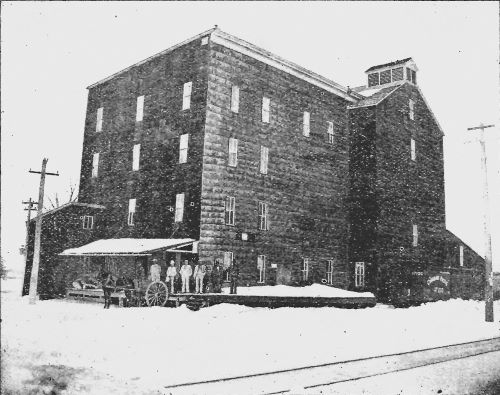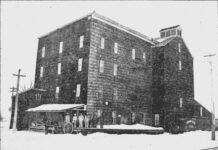Towards the end of the nineteenth century, a major social and technological revolution was happening across Canada, and beginning to impact on life in Kemptville. The use of electricity to light streets and homes was just beginning, and entrepreneurs were taking advantage to generate more than power. In 1888, George Keating installed a generating plant in his woolen mills located on the bank of the South Branch beside the bridge at Prescott Street, bringing the first electric light system in the town. In 1888, an Agricultural Fair was held in the Odd Fellows Hall on Clothier Street east, and it became the first building in Kemptville to be lit by electric lights. It was quite an occasion, as lines were run especially for the event from Keating’s mill. Later that year, Keating installed a larger system at his mill which provided electric street lighting to the entire town.
In 1891, according to records, “Keating bought the Barnes’ grist mill, just across the river from his woolen mill, and behind the Holmes’ block, and installed a much larger plant to be operated by either water or steam, for Kemptville had a fairly high dam above the bridge then, and the flumes that had aided in running the grist mill did similar service for the electric light plant”. The age of electric street lighting had well and truly arrived and poles were erected along the main streets to carry the new wires.
The demand for electricity grew and, by the turn of the century, Keating’s system, which had been bought by John Collins after Keating’s death in 1894, was bought out in turn by A. Bowen and Sons, owners of the Kemptville Milling Company and a major figure in the commercial world of the day. The scene in 1903 was captured by local journalists:
“Well lighted streets and buildings is a very necessary condition in a progressive town and is in Kemptville well supplied by the above company, which is another of the industries developed by A. Bowen & Sons since coming to Kemptville….A stranger has but to note the brilliancy reflected from every street corner and from every public and many private dwellings to be assured that our system of electric light compares favorably with that of any town of even greater size.”
But Alonzo Bowen and his sons were not content with progress to date. The same year the glowing report quoted above was written, a banquet was held in Bowen & Sons’ honour to celebrate a major expansion of their business. The newspaper reported that “a banquet was tendered Mr. Bowen and his two sons for the development he had successfully carried out by moving the whole system to Andrewsville, or The Flats, mid-way between Burritt’s Rapids and Merrickville, where power was available to generate sufficient electricity to run their flour and feed mill (down near the station), to light the town and to have extra power for industry.”
Burritt’s Rapids enjoyed the benefits of this new power line, with electric lighting for streets and houses as the new lines ran through the village. For almost twenty years, Bowen & Sons prospered, building a substation on what is now Bridge Street in Kemptville, to control the power coming from Andrewsville. The Kemptville Milling Company, which they owned, operated a mill, situated on South Main Street (now Wellington Street). The facility, a 5-storey building with a grain elevator 75 feet high, produced between 60,000 and 70,000 bushels of grain every year, and was on a railway branch beside the CPR Station.
The control over electricity supply, along with the importance of the mill, made the company one of the most influential businesses in the area. When Alonzo Bowen died, his two sons, Dan and Levi, took over the reins of the company.
Unfortunately for the Bowen brothers, there was to be no happy ending to their story. Just three years after he started operations at Andrewsville, the Hydro-Electric Power Commission of Ontario (HEPCO), predecessor of Ontario Hydro, was established by the Ontario Government. Designed to transmit electricity generated at Niagara Falls, the new Commission quickly grew and took over many of the locally-owned generating companies in Ontario. By 1922, the Commission had almost a monopoly on power generation and transmission in Ontario, and began to negotiate with local municipalities to provide their electrical needs. By then, Bowen’s plant at Andrewsville was no longer providing sufficient power for the increasing needs of the region, leaving many of his customers in darkness for much of the time: “…for mere red lights showed where bright lights should have shone”, as local media reported.
Dan and Levi Bowen were not about to give up their business without a fight. When the Village of Kemptville, as it was then, established its own Hydro-Electric Commission in 1922 to connect with the HEPCP services, the Bowens were ready to compete, planning a new expansion of their generating and distribution system, power fighting power in a fight to the death.







